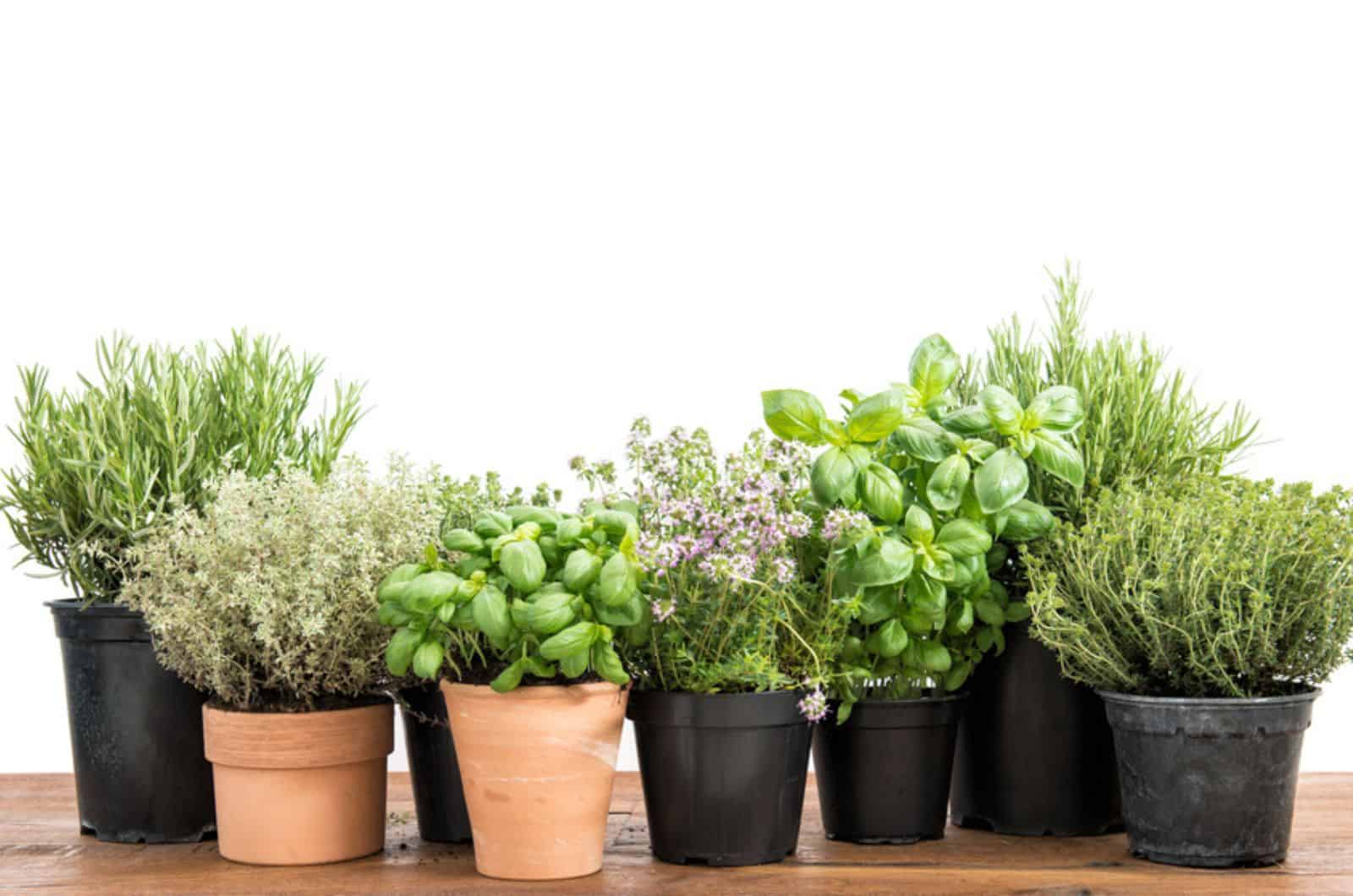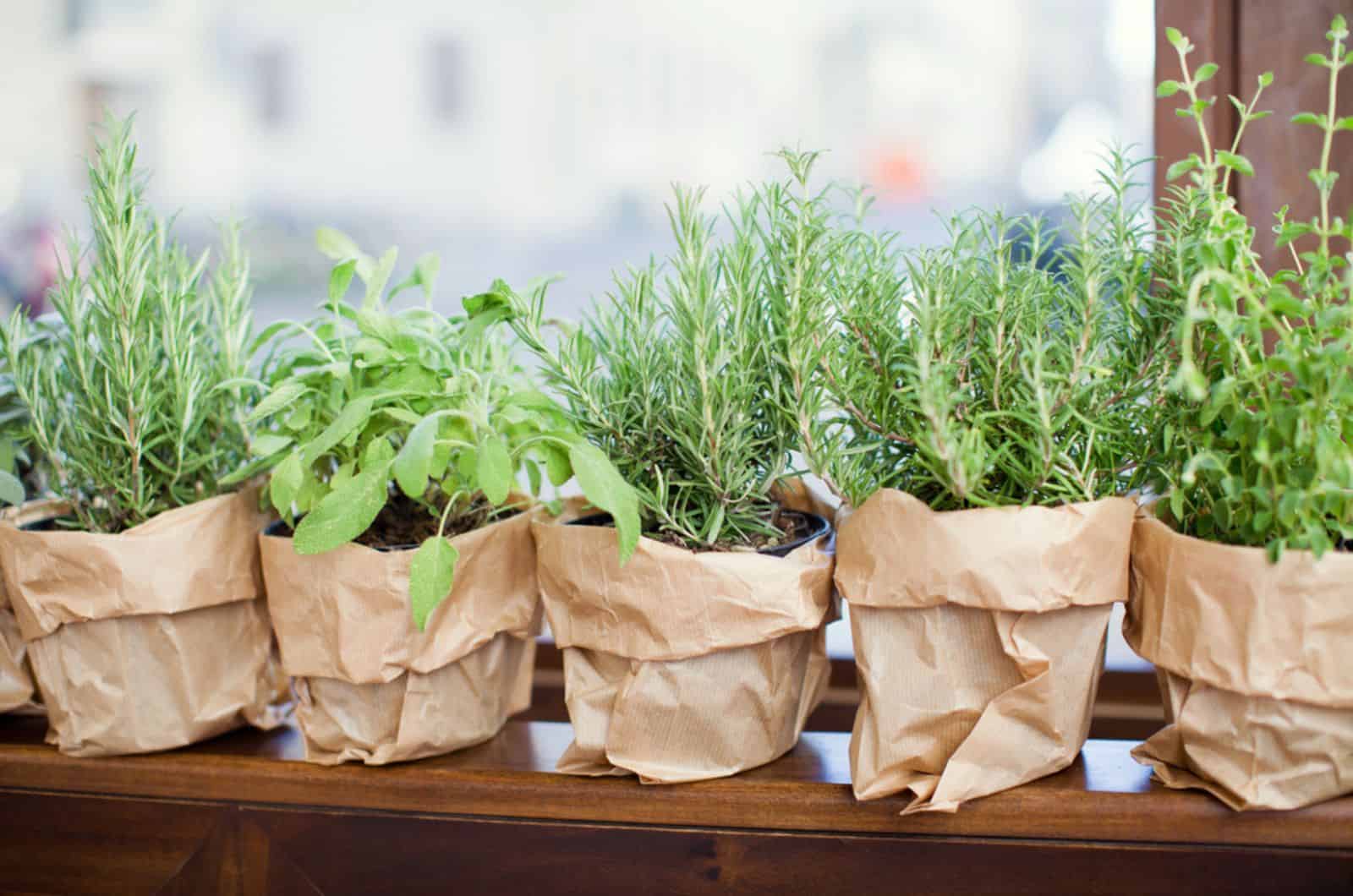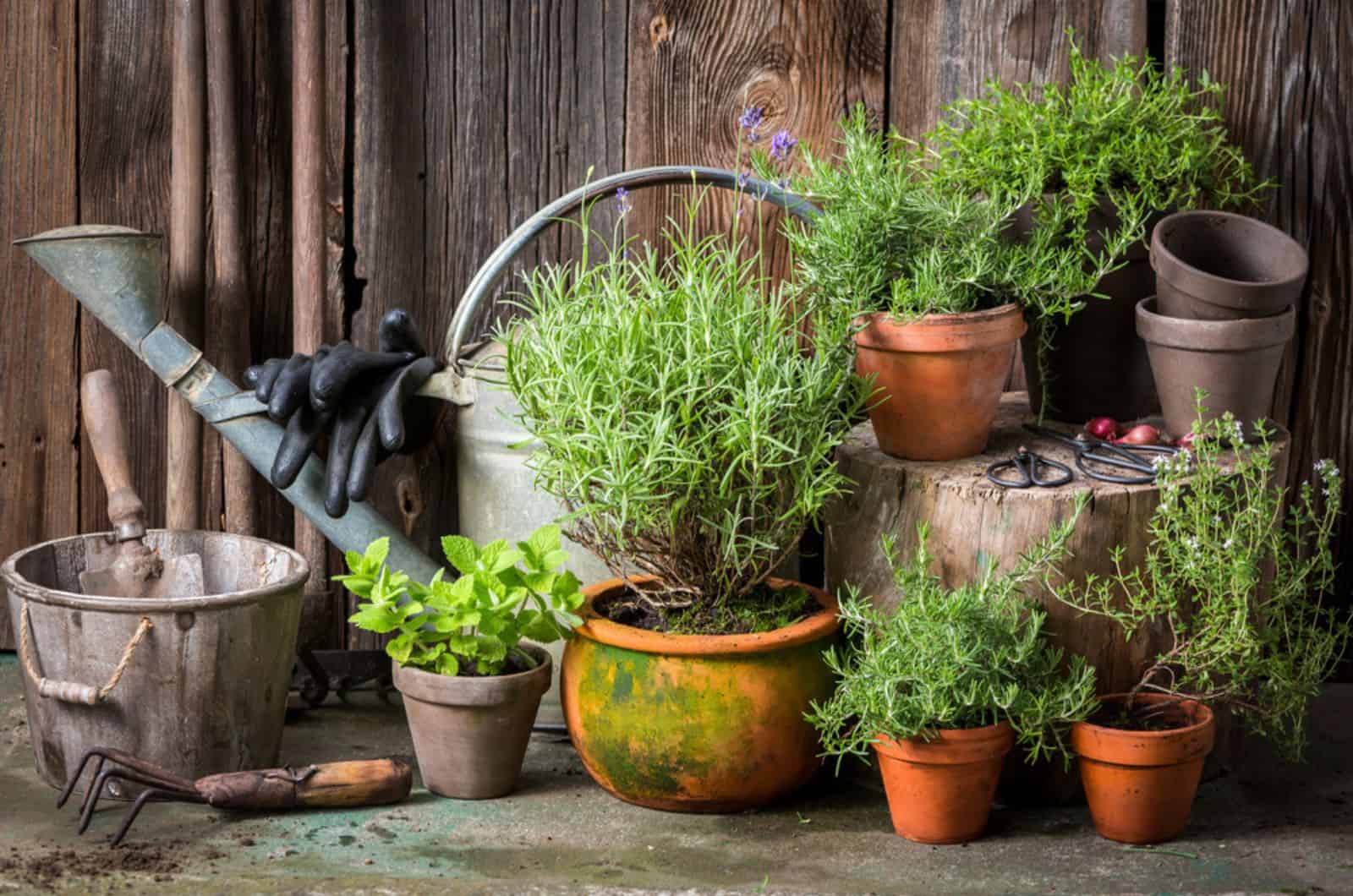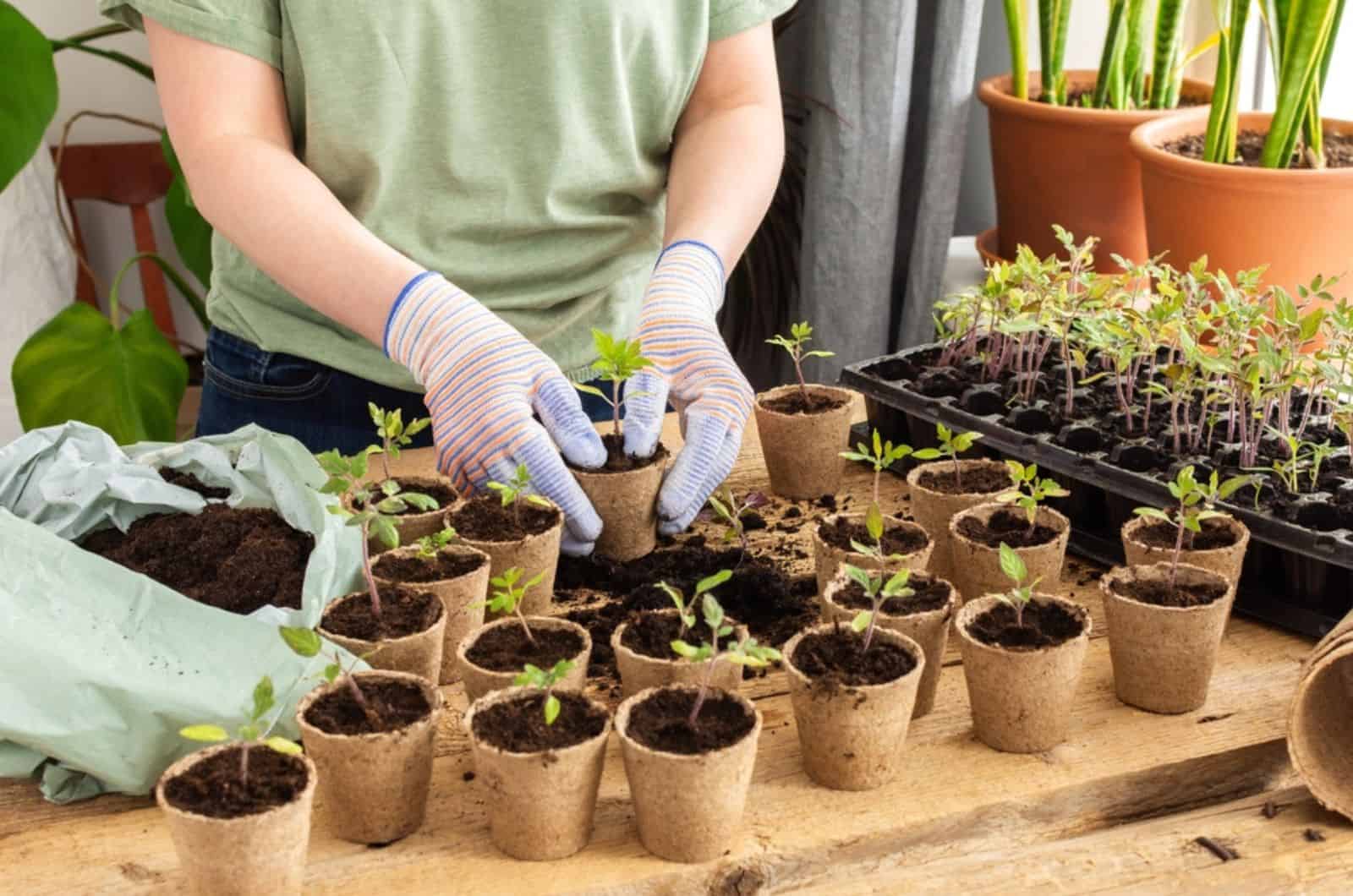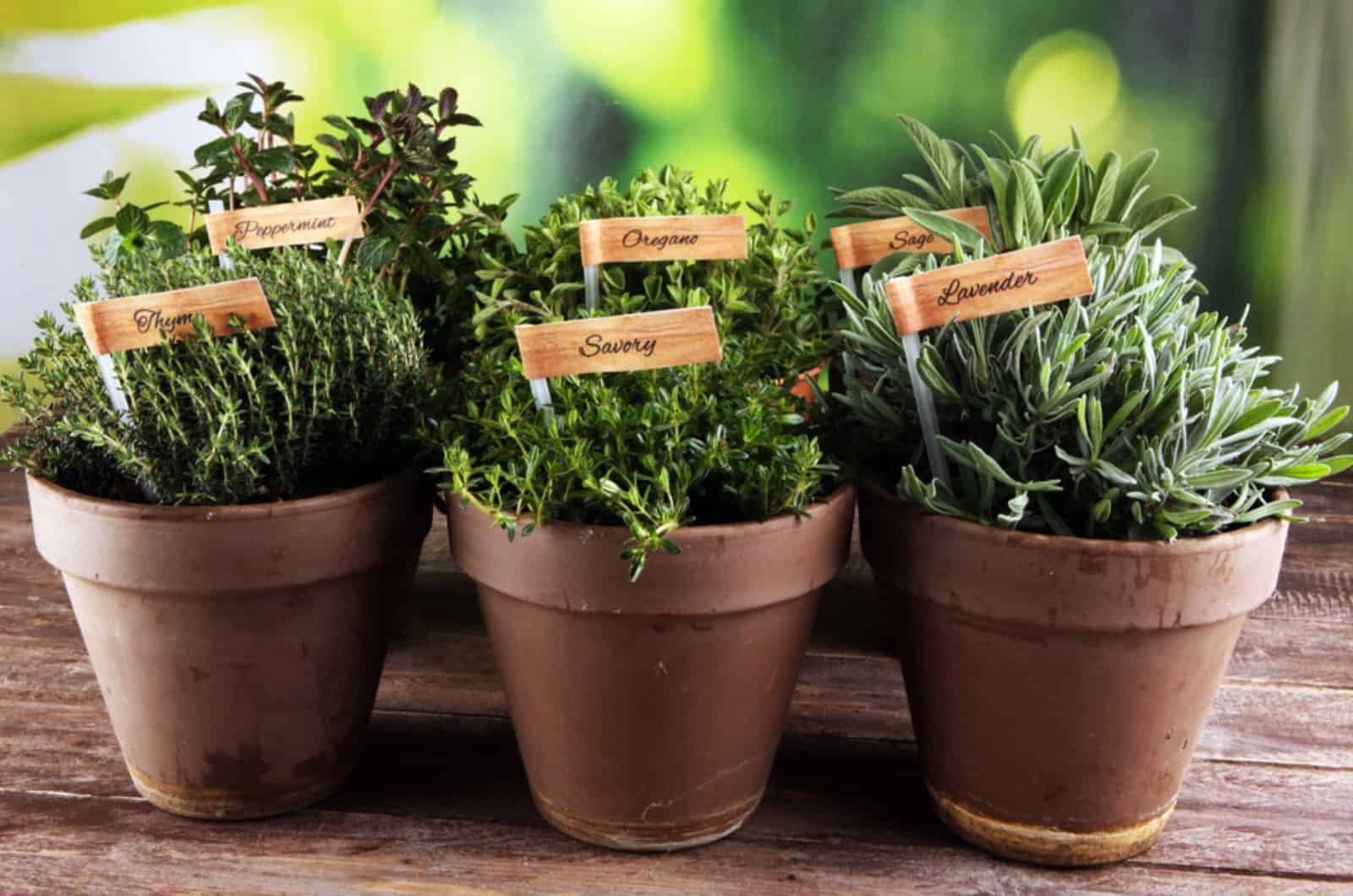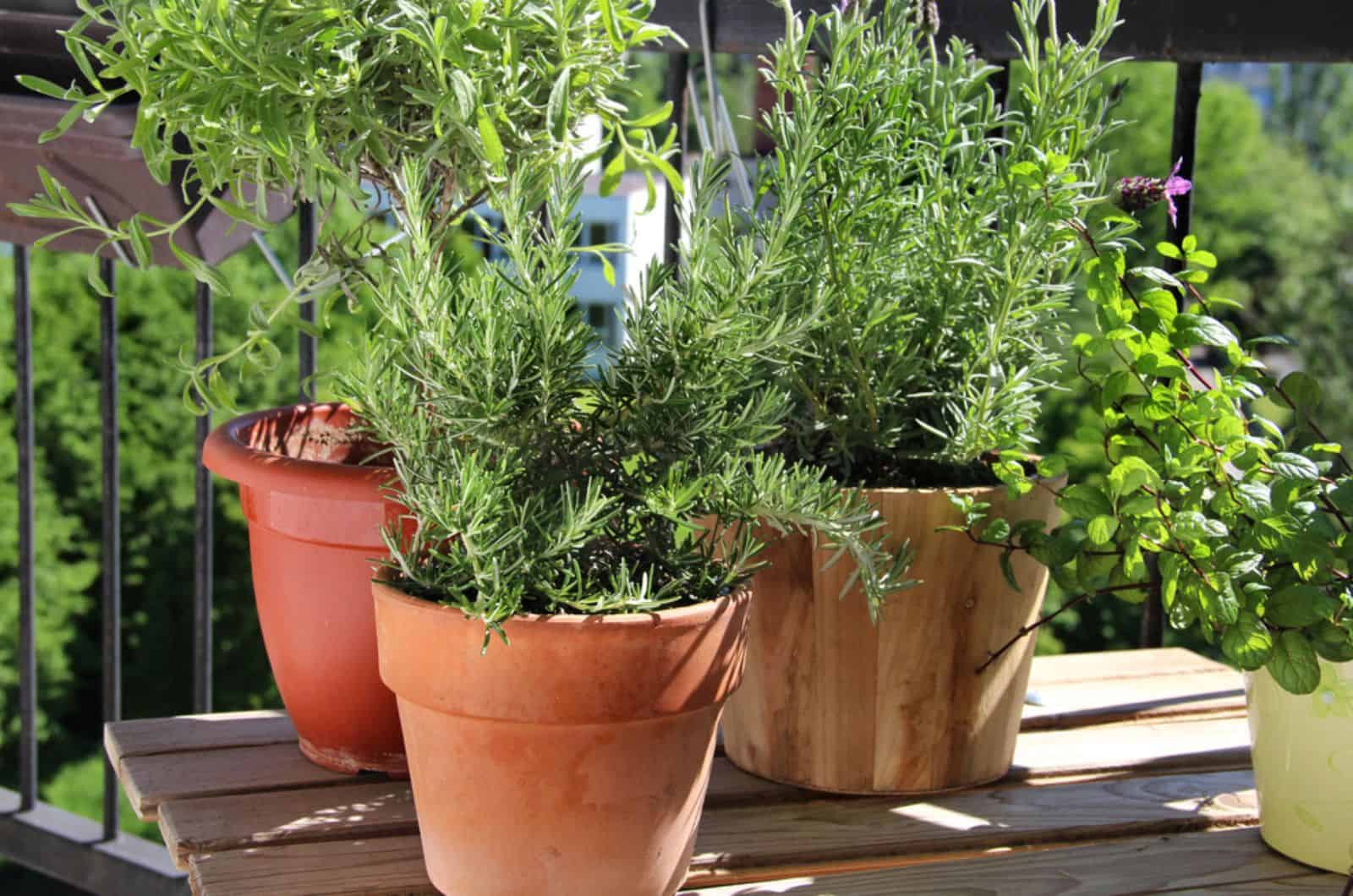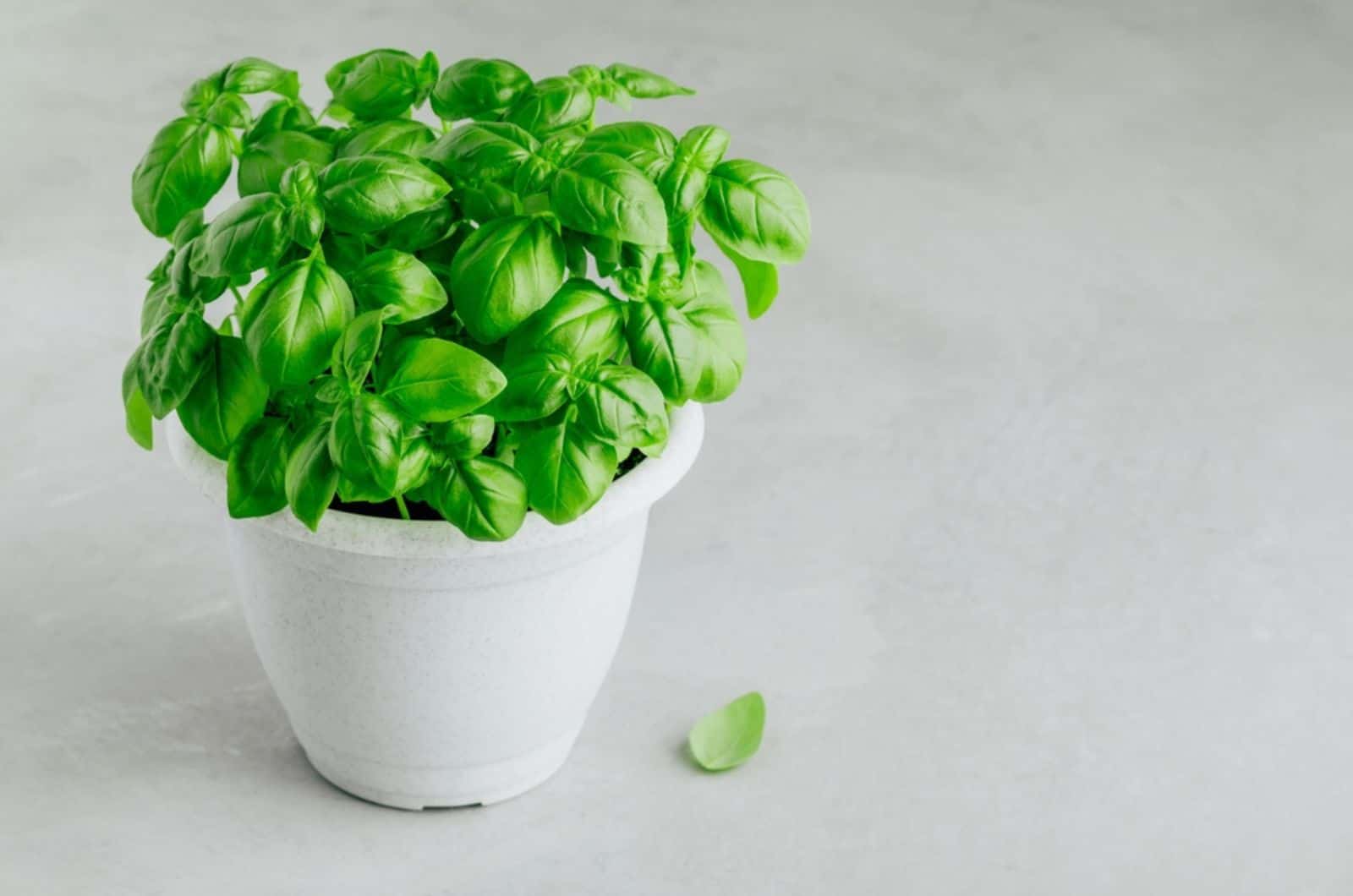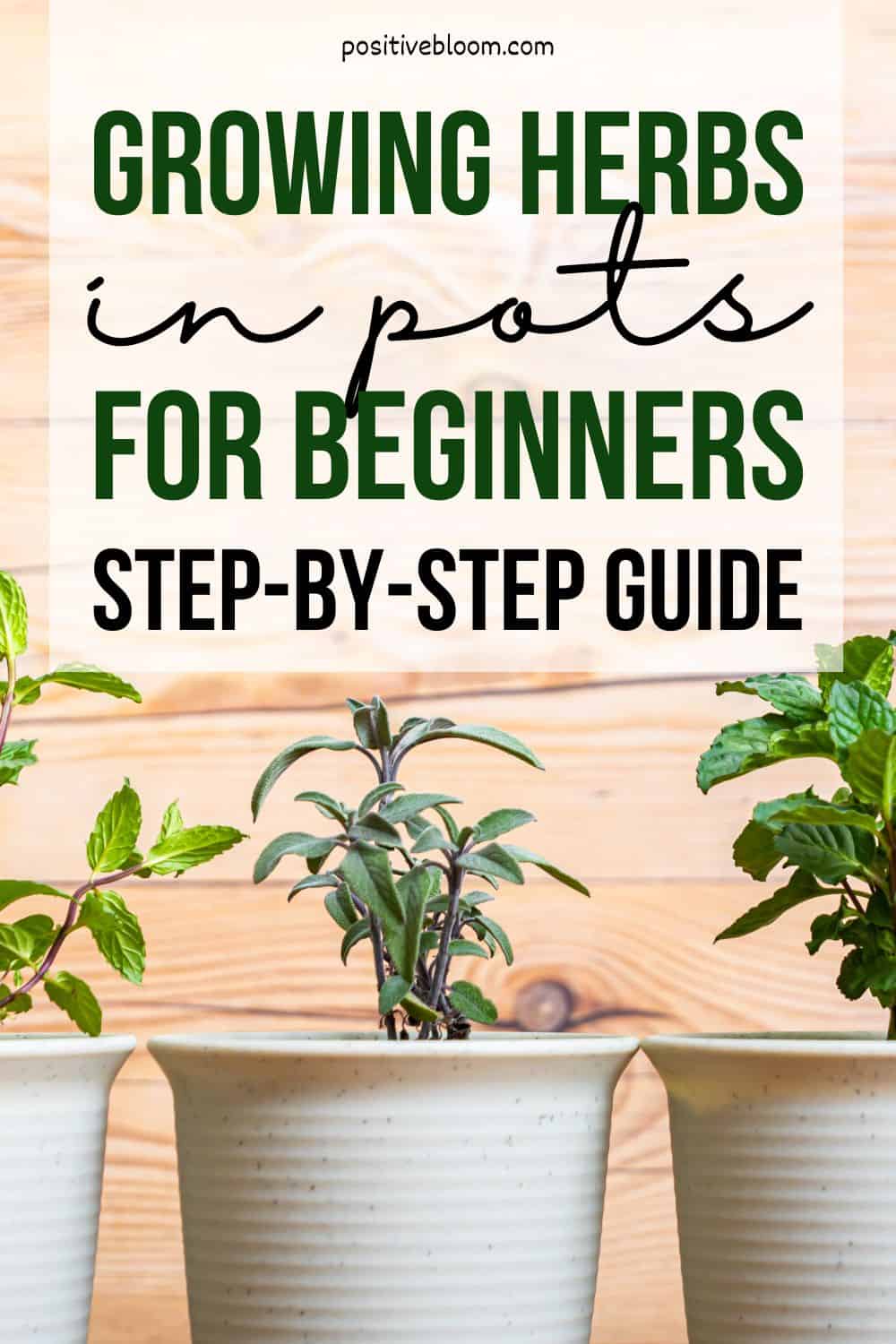Container gardening is so fun and rewarding!
You will be able to grow lots of fruits and veggies with container gardening, so you will be able to have fresh veggies without even leaving your apartment!
It is easier and more convenient because you don’t have to deal with annoying critters and weeds, and your plant won’t be affected by crazy weather changes either because you can simply bring it indoors where you can control the temperature and humidity.
Just imagine waking up and walking to your balcony on a hot summer day, and seeing tomatoes you grew yourself right there; it’s a dream come true!
A great thing about container gardening is that you can grow almost anything in them, including veggies, plants, herbs, flowers, and fruit. It is important that you put plants with similar needs in the same container.
Today, we are going to cover everything you need to know about herb gardens. Keep reading to learn step-by-step instructions for growing herbs in pots for beginners!
Growing Herbs In Pots For Beginners Guide
First, let’s discuss what a herb garden actually is! We’ll then look at how to choose the right herb for your indoor herb garden. This is extremely important because there are different regions in which the climate might not be suitable for all types of herbs.
You might grow your own herb garden in conditions that are not suitable for herbs, and end up with no herbs to harvest during the growing season.
Luckily, there are some gardening tips that you can use to get the best harvest ever.
Keep reading to learn everything about them!
What Is A Herb Garden?
A container herb garden is not the same thing as a vegetable garden, especially because growing herbs indoors does not require a lot of space, and you are growing herbs instead of veggies. Though there are some veggies that can grow perfectly well in pots, we are going to focus on growing culinary herbs.
A container herb garden refers to growing herbs in small pots, hanging baskets, or grow bags. You can also consider growing them in raised garden beds if you have enough space, or maybe try and grow them in recycled materials like milk crates.
This is a great way to always have fresh herbs when cooking or making tea, so you don’t have to go to the market or farm — all you have to do is walk to the balcony and pick some spices for your next meal!
You don’t have to live in a big apartment in order to grow herbs indoors because you can also grow them in pots that only take up small spaces. You can even grow them on a sunny windowsill if you don’t have a balcony!
Growing an indoor herb garden is a great way to save money — with all the prices rising these days, it’s nice to save a couple of bucks on cilantro or parsley!
You won’t have to spend much time and energy taking care of your little herb garden. You will have to provide them with some minimal plant care, but herbs are usually pretty easy to grow and don’t generally have any special requirements.
It is important to provide them with the right type of soil and put them in a place they can get direct sunlight throughout the day. With a few watering sessions every now and then, you will soon be able to pick your own kitchen herbs!
Materials Required To Grow An Indoor Herb Garden
You will only need a couple of things to grow an indoor herb garden, and you won’t have to spend as much money on gardening equipment as you would for a vegetable garden, which is another advantage of container gardening.
Here is what you will need:
• Grow lights or a sunny spot that gets at least 6 hours of sunlight during the day — growing them in full sun is completely free unless you don’t have windows that are exposed to the sun during the day, in which case you will have to invest in some quality grow lights.
• Potting soil — most herbs require well-draining soil that is also rich in nutrients. You can either buy this type of potting mix from a gardening store or make your own!
• Containers — this depends on the type of herb that you are planning to grow.
• Fertilizers — your plant will eventually run out of nutrients in the soil, so you will have to add some fertilizer to give your plant the necessary nutrients for growth and development. Consider using either an organic fertilizer that contains kelp, worm castings, and bone meal, or an all-purpose liquid fertilizer.
• Herb seeds or seedlings — seeds are cheaper, but they take longer to grow, while seedlings are already established. Some types of herbs, such as Rosemary, are difficult to grow from seeds.
• Watering can — these are great watering hose alternatives, especially for small potted plants, because the pressure is low and it won’t harm the delicate seedlings.
Choose The Right Herb
Choosing the right herb for your climate is extremely important. For instance, my friend can grow all kinds of herbs because she lives in the Mediterranean, but some of those herbs are impossible to grow in my region.
This is why it is important to figure out what USDA hardiness zone you live in before you start planting herbs. However, if you plan to grow an indoor garden, you can easily manipulate the growing conditions.
This means that you can keep the temperature high enough for the herbs to grow and develop. You can also invest in some grow lights to boost new growth and help those little leaves fully mature!
Even though some gardeners say that grow lights can burn your plants, I have personally never had that issue.
The next stop is the type of herb. Herbs can be grouped into annual and perennial herbs, and each must be grown in different settings. For instance, perennial herbs require deeper pots because their root systems tend to grow deep in the soil.
Let’s learn more about them!
Annual Herbs
Annual herbs are short-lived and finish their life cycle in only one growing season. However, they tend to seed themselves to make sure that they grow again the next growing season.
They have shallow roots and don’t require deep containers. Though they can grow perfectly fine in containers that are 8 inches deep, they will grow even more vigorously if they have more space.
Some annual herbs include:
• Basil
• Dill
• Chamomile
• Parsley
• Cilantro
• Chervil
• Summer Savory
• Tarragon
Perennial Herbs
Perennial herbs live longer and grow back each year, which is why they establish deeper roots!
Perennial herbs require pots or window boxes that are at least 12 inches deep and wide, though they might grow much more vigorously in larger pots.
If you plan on growing perennial herbs, get ready because they will take up your entire balcony! Don’t worry too much, you can easily prune them and harvest them for your delicious meals!
Some perennial herbs include:
• Sage
• Lavender
• Savory
• Rosemary
• Mint
• Chives
• Bay
• Thyme
• Marjoram
How To Grow Herbs In Pots: A Step-by-step Guide
Here are some easy herb gardening instructions. I’m sure that you won’t have any issues — just follow these steps, and you’ll be enjoying fresh herbs in no time!
Step 1: Planning The Herb Garden
As we mentioned, different types of herbs have different requirements. For instance, mint and parsley prefer growing in moist and humid environments, while rosemary thrives in hot and dry conditions.
You can’t put two herbs with opposite requirements in the same container because one of them is definitely going to be left unsatisfied!
Step 2: Choose The Right Container
You can grow herbs in any container as long as it has good drainage. Most herbs don’t have deep root systems, so you don’t have to necessarily grow them in deep containers. However, they will vigorously grow in a matter of time and they will need space to be comfortable.
Most herbs thrive in self-watering containers because they constantly require moist soil. These types of herbs include marjoram, chives, parsley, and mint.
On the contrary, herbs like oregano, basil, rosemary, and thyme prefer their soil to completely dry out before watering.
Nonetheless, good drainage is necessary for any type of herb, and the container should definitely contain drainage holes in the bottom.
Step 3: Planting Herbs
Now we are going to get our hands dirty!
First, you have to prepare soil that is well-draining and rich in nutrients. You can apply fertilizers before planting to improve the nutrient content, though this isn’t necessary if you bought high-quality soil.
Make a tiny hole in the soil if you are growing herbs from seeds. If you are planting the herb seedling, then you should make a hole in the soil that can fit the entire root ball.
Carefully put the seedling in the pot without damaging its delicate roots. Slightly tap around the base of the seedling to finish up!
Step 4: Seedling Plant Care
It is important that seedlings receive 6 to 8 hours of direct sunlight each day. If you can’t find a place with these light conditions, you can invest in some grow lights.
Depending on the variety, you will either have to let the soil completely dry before watering or check if the top few inches of the soil have dried out. If so, then it is time to water the plant to keep the soil moist. If not, postpone watering for a few days.
Consider removing small herbs from the sun during hot summer days as they can get burned.
When it comes to fertilization, these plants love plant food!
However, they are often prone to overfertilization so you should carefully follow the instructions displayed on the packaging. I usually apply my liquid fertilizer every week, though I sometimes skip if I notice that the seedlings stop growing.
This is because too many chemicals and salts from the fertilizer can build up in the soil, which prevents the roots from normally absorbing nutrients and water.
Step 5: Harvesting
Now it’s time to use these delicious herbs to spice up your meals!
You don’t have to wait for the herbs to fully mature, and you can even start harvesting small herbs to boost their growth so you end up with a larger harvest!
You can simply cut them off or pick them with your fingers. Always make sure that you don’t remove more than one third of a plant at once because they still need leaves to perform photosynthesis and remain healthy.
Even though you will mostly pick leaves, with some herbs like chives and dill you can even eat the flowers and seeds!
Some herbs like basil and oregano should be harvested before flowering because they will lose their unique flavor and turn bitter once the blossoms start emerging.
Keep in mind that a plant’s seasonal growth cycle is finished after it blossoms and sets seed. After that the plant will no longer produce new growth.
However, you can bring your herb indoors for overwintering!
Read also: A Guide On How To Harvest Cilantro Without Killing The Plant
Step 6: Overwintering
If you bring your herbs indoors and keep them nice and warm, they will produce those delicious leaves in winter as well!
If you don’t bring them indoors, some perennial types will simply die off and come back again the next season. This is not the same with annuals, which have to be replanted again.
However, you can extend their growing season by bringing them indoors once the temperatures drop.
Step 7: Storing The Herbs
A great thing about these plants is that they have a long shelf life — you can simply dry them out to preserve them for a longer period of time.
To completely dry out your herbs, use a food dehydrator or an oven on the lowest temperature. After that, they can be kept for months in an airtight jar.
Growing Herbs In Pots: Pros & Cons
There are numerous benefits to indoor herb gardening. However, there are always two sides to every story.
Let’s look at the pros & cons of container gardening!
Pros
• Beginner-friendly — most herbs are easy to grow because they don’t have any special requirements and can tolerate some inconveniences. For instance, if you forget to water them every now and then, your plant won’t immediately die off.
• You can move them — this is the main reason indoor gardens are awesome! You can simply move your plants indoors if the weather turns, and you can also put them outdoors when the sun is shining.
• Companion planting — similarly to growing veggies in a container, you can combine different herbs that will encourage the growth and development of each other.
For instance, Lavender can attract beneficial insects that are necessary for pollination, which is why they are often combined with various veggies.
• Don’t take up a lot of space — depending on the variety, most herbs are small and can grow in small pots that don’t take up a lot of space. Even if you are living in a tiny one-bedroom apartment, you can still consider indoor gardening.
• Limits invasive herbs — some herbs, such as creeping thyme, would spread all over your garden and maybe visit the neighbors too! When growing herbs in containers, you limit their space so they are not able to spread all over the place!
• Accessibility — you can put the pots anywhere you want as long as they receive direct sunlight. This means that you can keep them on a windowsill in your kitchen, so you don’t even have to go to the balcony or bend your knees to get your herbs. They also have a nice fragrance, and greenery is always a great decorative element.
Cons
• Containers limit growth — the herbs can only grow as much as the container allows them to. While this is a great way to prevent invasive herbs, it’s not as great for the larger types that need more space for optimal growth. The herb might grow leggy, and it won’t have the best flavor.
• Frequent watering — pots tend to dry out quicker, so you will have to water your herbs more frequently. This is not a big issue, though you will have to track if the soil has completely dried before watering.
• Pots tend to get too hot — this especially applies to dark containers, which will get extremely hot when kept in full sun during hot summer days. You will sometimes have to put the herbs in the shade to prevent sun damage.
• Rootbound — herbs can outgrow their containers, which is why they stop growing. A sign that your herb is rootbound is roots coming out of the drainage holes. In this case, you will have to repot the plant in a slightly larger container.
• Soil needs to be replenished — because there isn’t much soil in a container, it takes a lot of soil, compost, and plant food to maintain the soil’s ideal conditions. This is something that cannot be neglected if you want your potted plants to thrive.
Best Herbs To Grow In Pots
If you are a beginner gardener unfamiliar with the types of herbs that can be grown in pots, here is a list of the ones that have the highest success rate!
Most of these herbs are available at local garden shops, and you can also look them up on Amazon. I’m sure you will find their seeds for just a couple of bucks.
Let’s take a look at the best herbs to grow in pots.
1. Lemon Balm
This is a small herb that won’t take up a lot of space. It is similar to mint (they are cousins), which is why they can be grown together. Chemicals in lemon balm appear to have sedative and soothing effects. It might also inhibit the development of certain bacteria and viruses.
Lemon balm is used for treating cold sores, stress, and anxiety, and also other conditions such as insomnia and dementia. However, it must be noted that this is not supported by science.
Nonetheless, it has a great lemony flavor that’s extremely delicious. They are also low-maintenance, and you only have to make sure to keep their soil moist.
2. Cilantro Or Coriander
Cilantro offers a number of health benefits, and cilantro microgreens are particularly abundant in beta carotene and lutein, two essential elements that enhance vision, are good for the skin, and fight cancer.
Additionally, it has significant amounts of vitamin K, which aids in blood clotting, and vitamin E, which strengthens your immune system.
As cilantro grows quickly, you might be able to use it to season food sooner than you anticipated! However, this plant is delicate and requires a lot of care, so it is crucial to understand exactly how to cultivate cilantro microgreens.
Read also: How To Get From Seeds To Cilantro Sprouts: All The Answers And More
3. Basil
Basil is definitely my favorite herb!
It can be grown basically anywhere, though I like to keep it in warm temperatures where it can get plenty of sun. It requires frequent harvesting, and will grow out of the pot if you don’t prune it enough.
Basil is filled with minerals, vitamins, and antioxidants that are extremely beneficial to our health, and is also used to make essential oils!
Some of the benefits include stress reduction, blood sugar regulation, cancer and heart disease prevention, inflammation reduction, and protection against viral infections.
4. Rosemary
Rosemary produces needle-like leaves. They have a strong and unique fragrance, which is why they are often added to chicken and potatoes.
Depending on the region, rosemary can be grown as either an annual or perennial. It needs plenty of sunshine during the day and soil that is constantly moist. They like moist soil, not wet soil, and they can be damaged by frequent watering.
Regarding health benefits, the antioxidants and anti-inflammatory chemicals found in abundance in rosemary are known to help strengthen the immune system and enhance blood circulation. Rosemary is regarded as a cognitive stimulant and can enhance the effectiveness and quality of memories. It is also believed to increase intelligence, focus, and awareness.
5. Oregano
If you love pizza, then you have to try and grow your own oregano. Oregano leaves are packed with delicious flavor that is simply perfect for pizzas and bruschetta, though I eventually started adding oregano to almost every meal!
It has small green leaves and purple flowers, which can also contribute to your home decor. Also, it smells absolutely amazing!
There are numerous health benefits, including gut health improvement, lowering cholesterol, pain relief, cancer prevention, treating yeast infections, and so on.
To Sum Up
It is quite easy to grow an indoor herb garden! Not only will it improve your home decor and make it look more lively, but these herbs can be used for making teas and cooking. They are primarily grown for culinary uses, but there are other benefits that come with these small herbs!
Most of them have unique flavors, strong fragrances, and numerous health benefits. Not to mention that they can make meals more delicious (especially basil!).
Growing an indoor herb garden is great for gardening beginners as they won’t spend much time planting them, and there aren’t any special requirements to pay close attention to.
Just carefully follow our step-by-step guide on growing herbs in pots for beginners, and you will have your own little herb garden in no time!
I hope this article was helpful.
Until next time!
Like this post? Share or pin it for later!

